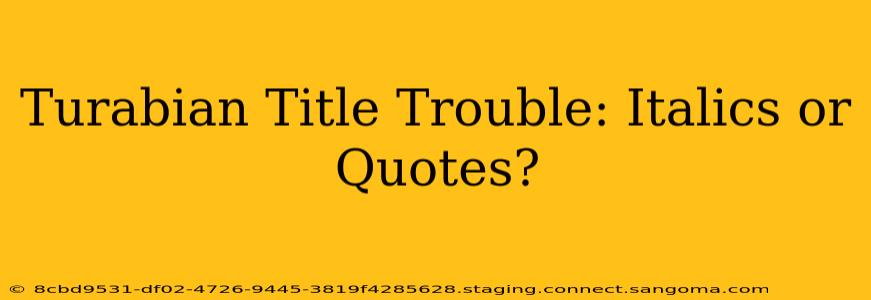Choosing the correct formatting for titles in Turabian style can be confusing. The rules depend on the type of work you're citing, not just the length. This guide will clarify the nuances and help you avoid common mistakes. We'll also address some frequently asked questions to ensure you master Turabian title formatting.
What is the Turabian style?
The Turabian style, also known as the Chicago Manual of Style, is a widely used citation style, particularly in the humanities. It offers detailed guidelines for formatting academic papers, including the proper handling of titles. Understanding these guidelines is crucial for presenting your research professionally and avoiding plagiarism.
When do I use italics for titles in Turabian?
In Turabian, you use italics for titles of larger, more substantial works. This includes:
- Books: The Great Gatsby, To Kill a Mockingbird
- Journals: The American Historical Review, Nature
- Newspapers: The New York Times, The Wall Street Journal
- Magazines: Time, The Atlantic
- Films: Citizen Kane, Casablanca
- Database Names: ProQuest, JSTOR
When do I use quotation marks for titles in Turabian?
Quotation marks are reserved for shorter, self-contained works. These include:
- Articles in journals or magazines: "The Impact of Social Media on Political Discourse"
- Chapters in books: "The Rise of Nationalism in 19th Century Europe"
- Essays: "The Ethics of Artificial Intelligence"
- Short stories: "The Lottery"
- Poems: "The Raven"
- Songs: "Bohemian Rhapsody"
- Webpages/Articles within a larger website (unless the website itself is the main focus): "Understanding SEO," from www.example.com
What about titles within titles?
When you have a title within a title (for example, an article title within a journal), use the appropriate formatting for each title. The larger work (the journal) is italicized, and the smaller work (the article) is in quotation marks.
For example: "The Impact of Social Media on Political Discourse," The Journal of Communication, 70(2), 100-120.
How do I handle subtitles?
Subtitles are treated as part of the main title. They should be connected to the main title with a colon. Use italics or quotation marks based on the type of work, as described above.
For example: The History of the United States: A Concise Overview.
What if the title is in a different language?
Titles in other languages are still italicized or put in quotation marks based on their type (book, article, etc.), following the rules outlined above.
Are there exceptions to these rules?
While these guidelines are generally followed, some publications or instructors may have slight variations. Always check your specific style guide or your instructor's instructions for any exceptions.
Can you provide more examples?
Here are a few more examples to illustrate the proper use of italics and quotation marks in Turabian style:
- Book: The Lord of the Rings
- Journal Article: "The Effects of Climate Change on Coastal Communities," Environmental Science & Technology, 55(1), 1-10.
- Website: www.example.com (Note: You usually don't italicize the entire URL, but instead, cite specific pages from it within quotation marks).
- Song: "Imagine"
By following these guidelines, you can accurately format titles in your Turabian papers, contributing to clear and professional academic writing. Remember to always double-check with your specific style guide or instructor for any unique requirements.

